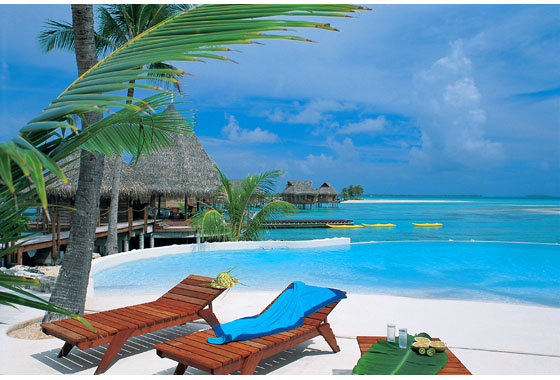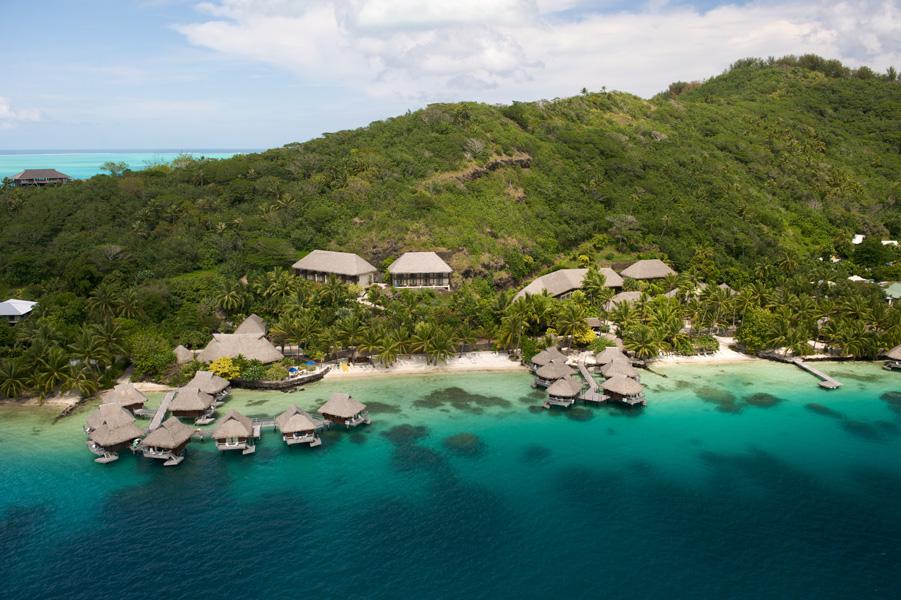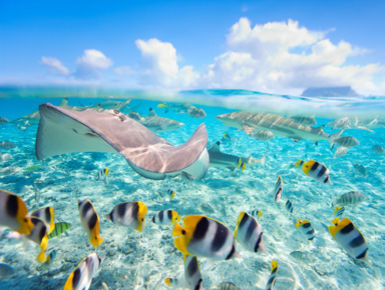
Clear Waters, Big Animals and Bright Reefs
The Islands of Tahiti deliver an enticing combination of topside beauty and underwater excitement. Reef life and dramatic walls are in the mix, but the big draw for many are sharks. Encounters are common, but not threatening. Whitetips and blacktips are often joined by lemon sharks on feeding encounters within lagoons, while walls and current-washed channels attract gray reefs, silky, bulls, hammerheads, silver tips and more. These same spectacularly clear waters hold manta rays, dolphins, sea turtles and swirling schools of jacks, tuna and barracuda. Divers less interested in the ocean's apex predators can relax in sheltered coral gardens, where rays and reef fish gather.
Highlights
- Best for: Both easy diving and exciting big animal encounters
- Best season to visit: Year round
- Weather: North America's summer and early fall are the coolest and driest months in Tahiti, with temperatures ranging from 70 to 82 degrees. November to March is a bit warmer, with more chance of rain, but there is no bad time for a visit
The Islands of Tahiti Information
About Diving in the Islands of Tahiti
The Islands of Tahiti are either volcanic peaks ringed by coral reefs, or low-lying atolls made up of coral reefs. Either way, dive sites will fall into one of the several general categories. Sand-bottomed lagoons sprout coral heads that harbor colorful tropicals and provide relaxing, current-free dives. This is also where many shark feeds take place. The inner slopes of fringing reefs provide more structure and habitat for resident marine life but remain largely current free. Outer reef slopes provide dramatic drops in exceptional clear waters, while the channels that cut through the reefs attract schooling fish and sharks on tidal changes, creating exciting opportunities for drift dives and big animal viewing.
Diving in the Islands of Tahiti Tips
Most divers know that shark diving is not the daredevil sport the general public perceives it to be. Follow a few simple rules such as wearing non-contrasting dive gear, and you are not going to attract attention. In fact, your bigger challenge will be finding the right vantage point to get in close and capture the action. Fortunately, the clear, light-filled water found at many feeding sites will allow you to create well-exposed shark portraits without complicated strobe lights.
Best Places to Dive in the Islands of Tahiti
At Tahiti's Shark Valley and Bora Bora's Motu Tapu, blacktip reef sharks are the appetizer, and big lemon sharks the main course. Miri Miri adds roving bands of large Napoleon wrasse to the mix of reef dwellers and schooling fish, while similar-sounding but distinctly different Muri Muri is known for turtles, tuna and the occasional pod of dolphins. Milder currents at Avatoru Pass allow all divers to enjoy the drift, while Tiputa Pass ramps up the excitement on a high-voltage drift that begins at a shark-filled cavern. For a relaxing break from the feeding action, join the schooling snapper and sergeant majors on the coral heads of the Aquarium, or follow eagle rays along the reef at Too Pua. Year-round water temperatures remain in the mid 80s at most sites.
What to Pack for Diving in the Islands of Tahiti
On any dive where currents are present, bring the surface marker and deployment reel. Include an underwater camera with a medium-wide lens for shark portraits. Add a light hood and non-contrasting gloves to blend in on feeding dives—it's actually not the sharks but the little reef critters that might nip annoyingly at a pale, waving hand that resembles a fishy bit.
Specials

The Islands of Tahiti
Le Tikehau by Pearl Resort
Rate from $2,291 per person/double diver through 3/31/26.
Rate from $4,594pp dbl/dvr 4/1/26-4/30/26.
Rate from $5,867 pp dbl/dvr 5/1/26-6/30/26.
Book by January 31, 2026. Rates subj to currency exchange. Book on-line or Contact Caradonna Adventures at 800-330-6611 or email us sales@caradonna.com.
From $2,877 per person double diver
Book Now
The Islands of Tahiti
Maitai Rangiroa Resort
Rate from $2,291 per person/double diver through 3/31/26.
Rate from $2,356 per person/double diver 4/1/26-4/30/26 and 11/1/26-3/31/27.
Book by December 31, 2025. Rates subj to currency exchange. Book on-line or Contact Caradonna Adventures at 800-330-6611 or email us sales@caradonna.com.
From $2,291 per person double diver
Book Now
The Islands of Tahiti
Havaiki Lodge Fakarava
Rate from $2,338 per person/double diver 1/23/26-3/31/26.
Rate from $2,412 per person/double diver 4/1/26-4/1/27.
Subj to currency exchange. Book on-line or Contact Caradonna Adventures at 800-330-6611 or email us sales@caradonna.com.
From $2,338 per person double diver
Book Now
The Islands of Tahiti
Hotel Kia Ora Resort and Spa
Rate from $2,844 per person/double diver 1/5/26-4/30/26.
Rate from $3,547 per person/double diver 5/1/26-10/31/26.
Rates subj to currency exchange. Book on-line or Contact Caradonna Adventures at 800-330-6611 or email us sales@caradonna.com.
From $2,844 per person double diver
Book Now
The Islands of Tahiti
Manava Beach Resort & Spa Moorea
Rate from $2,625 per person/double diver through 10/31/25 & 12/23/25-12/31/25.
Rate from $2,224 per person/double diver through 11/1/25-12/22/25.
Additional room categories and other dates also available! All rates are subject to currency exchange at time of reservation. Book on-line or Contact Caradonna Adventures at 800.328.2288 or email us sales@caradonna.com.
From $2,224 per person double diver
Book Now
The Islands of Tahiti
Maitai Polynesia Resort Bora Bora
Rate from $1,704 per person/double diver 11/1/25-12/31/25.
Rate from $1,813 per person/double diver through 10/31/25.
Additional room categories and other dates also available! Rates subj to currency exchange. Book on-line or Contact Caradonna Adventures at 800.328.2288 or email us sales@caradonna.com.
From $1,704 per person double diver
Book Now
The Islands of Tahiti
Sofitel Kia Ora Moorea Beach Resort
Optional add-ons for Watersports Activities and Topside Activities available in the shopping cart after room category is selected.
Valid 4/1/25-4/30/25 & 11/1/25-12/21/25 & 1/5/26-3/31/26. Rate from $2,806 per person, dble diver.
Additional room categories and other dates also available! All rates subject to currency exchange at the time of reservation. Book on-line or Contact Caradonna Adventures at 800.328.2288 or email us sales@caradonna.com.
From $2,807 per person double diver
Book NowResorts

The Islands of Tahiti
Maitai Rangiroa Resort
See Packages & Learn More

The Islands of Tahiti
Havaiki Lodge Fakarava
Annual Closure from December 22, 2025, to January 22, 2026.
Book on-line or Contact Caradonna Adventures at 800.328.2288 or email us sales@caradonna.com.
See Packages & Learn More

The Islands of Tahiti
Hotel Kia Ora Resort and Spa
See Packages & Learn More

The Islands of Tahiti
Manava Beach Resort & Spa Moorea
See Packages & Learn More

The Islands of Tahiti
Niu Beach Hotel Moorea
See Packages & Learn More

The Islands of Tahiti
Le Tikehau by Pearl Resort
Book on-line or Contact Caradonna Adventures at 800-330-6611 or email us sales@caradonna.com.
See Packages & Learn More

The Islands of Tahiti
Maitai Polynesia Resort Bora Bora
See Packages & Learn More

The Islands of Tahiti
Le Bora Bora By Pearl Resorts
Book on-line or Contact Caradonna Adventures at 800.328.2288 or email us sales@caradonna.com.
See Packages & Learn More
Diving in the Islands of Tahiti
Tahiti is actually just one of many islands in the group that were historically known as French Polynesia. Today, the name Tahiti is often used to refer to the entire 118 island group, which is spread out across a million square miles of ocean. But that's OK because of the answer to “how's diving in Tahiti?” applies equally to all of the islands. And that answer is “really good.” The excellent water clarity that is a hallmark of many sites allows sunlight to penetrate and bring out the full colors of fish and corals, and to illuminate steep slopes and walls down to vertigo-inducing depths. The tidal forces that cause these waters to ebb and flow through island lagoons nurture a dynamic food chain that begins with small reef dwellers and ranges up to mantas, sharks and pelagic fish. Tahiti and the other islands of the Society Group feature tall, green-clad mountains surrounded by reefs. In the open ocean far to the east, five large coral atolls encompass dozens of small islands and thousands of acres of shallow reefs, all surrounded by coral walls that plunge into the depths. Divers can experience the islands from land-based resorts or by liveaboards. After flying into Faa'a International Airport, travelers might consider spending a day or two on the island of Tahiti to take in the topside sights and the underwater action at Shark Valley. or perhaps take a tune up dive on a shallow World War II wreck. An easy ferry ride brings divers to the resorts of Moorea Island, where sharks, turtles and rays patrol coral canyons and valleys, and schools of blue-lined snapper, bigeye and cardinal fish gather on the hard coral slope of the outer reef. Operators stage feedings that attract gray reef sharks, blacktips and lemons, but these sharks are often in evidence even without the enticement of a free meal. Even divers accustomed to shark encounters will be impressed by the swirling tropical fish and the ways colors are accentuated by bright sunlight. Moorea also offers a number of good snorkel sites, including a sandbar where stingrays gather. A domestic flight brings divers to Bora Bora's wide lagoon, which shelters groves of boulder and antler coral that are the home waters of large lemon sharks. Purple and yellow corals line the walls of Teavanui Pass, and manta rays glide into the lagoon to gather at the site known as Anua. The twin islands of Raiatea and Taha'a share a lagoon and reef line that encompasses a number of seamounts, caverns and grottoes, along with a unique site covered in fields of montipora coral that resemble a garden of roses. Inter-island air service also gives access to the low-lying Tuamotu Atolls. Rangiroa is the second-largest atoll in the world, and with each tide change, the entire inner lagoon funnels through a pair of deep passes in the reef wall. Avatoru Pass offers spectacularly clear water and moderate currents that allow divers of all skill levels to enjoy a drift past coral-covered walls and into the open ocean, where sharks, tuna and turtles gather at the outflow. At Tiputa Pass, the action starts deeper and the water runs faster, propelling divers into a swarm of gray reef sharks. This site also provides a chance for manta ray sightings, and meetings with pods of dolphin outside the pass. In the Tuamotus, divers encounter a school of sharks at the mouth of Fakarava’s south pass that is so thickly packed it resembles a solid wall of gray. Liveaboard cruises offer a chance to visit even more remote venues, with adventures that can include seasonal humpback encounters with humpback whales.
Passport and/or Visa Requirements
A valid U.S. passport is required for entry into Tahiti which must be valid for 3 months beyond your date of entry. Your passport needs to have at least 1 blank page for the Tahiti entry stamp. Proof of return or onward ticket is required. No visas are required for tourist stays of less than 90 days.
Immunizations
No immunizations are required for entry into Tahiti, but we would always suggest that you check with your doctor and the Centers for Disease Control on recommended vaccinations for travel to Tahiti at Traveler's Health CDC.
Culture and Customs
Tahiti and the Society Islands loom large in our collective images of tropical paradise. These are the islands that seduced the crew of the Bounty to mutiny, inspired the works of Gauguin and Melville, and now entice celebrities, newlyweds and dreamers to escape the every day for a thatch-roofed bungalow perched over an electric-blue lagoon. As a semi-autonomous territory of France, the islands combine Continental flair with the ancient traditions of Polynesia. Evidence of this blending begins at breakfast, where a bowl of cafe au lait and a buttery croissant are accompanied by fresh papaya, mango and breadfruit, served with a spray of tropical flowers. Tattoo is a Tahitian word, and body art is considered a sign of beauty. Dance has always played an important role in island life, with performances for everything from welcoming visitors to challenging an enemy or seducing a mate. Traditions are kept alive at the annual gathering of Heiva i Tahiti, when islanders from across the archipelago gather at Papeete for celebrations that include elaborate spectacles of song and dance, along with arts and crafts fairs and traditional sporting events such as canoe races and strong man contests. A year-round staple of Tahitian culture are flowers, which grow in abundance across the islands. Bright blossoms are worn in floral crowns or as single displays behind the ears, denoting either one's availability or commitment. The same long-standing traditions of hospitality that welcomed early European explorers and subsequent generations of sailors are now lavished on arriving vacationers, who will discover not only some of the friendliest people in the world, but also some of the most seductive landscapes, where sea, sky and island come together in riotous shades of blue and green.
Electricity, Phone and Internet Access
Electricity in Tahiti is 220 Volts, 60 cycles. Hotels may use 110 or 220 Volts depending on your location, so a converter/adapter is often required for appliances you bring, including computers.
Direct dialing international calling is available in most hotels. When calling from the U.S. to Tahiti, dial 011 and then the country code of 689 along with the local number. Check with your cell phone provider to see if they have an international plan that is compatible in Tahiti for voice, text and data.
Internet access is available in many hotels and resorts.
Water Quality
Tap water is safe to drink in Papeete and Bora Bora. Elsewhere bottled water is recommended and readily available.
Language & Currency
French and Tahitian are the official languages, but English is spoken and understood in tourist areas.
The currency of Tahiti is the French Pacific Franc (XPF). Bank notes come in denominations of 500, 1000, 5000 and 10,000, and coins in denominations of 1, 2, 5, 10, 20, 50 and 100.
Credit cards are readily accepted in most tourist destinations. Most guests exchange money at the airport upon arrival or at their hotel, but the best exchange rate should be at a local bank.
Time
There are three time zones in Tahiti. The Society Islands including Papeete and Moorea and the Leeward Islands including Bora Bora, and the Tuamotu Islands including Fakarava and Rangiroa are all 10 hours behind Greenwich Mean Time (-10 GMT). The Gambier Islands are 9 hours behind Greenwich Mean Time (-9 GMT). The Marquesas Islands are 9.5 hours behind Greenwich Mean Time (-9.5 GMT). Tahiti does not use daylight savings time.
Location, Size and Population
Tahiti is located south of the equator halfway between California and Australia. The islands of Tahiti, known as French Polynesia, consist of 5 island groups. There are 118 islands with a total land mass of 1,544 square miles.
The population of French Polynesia is 285,699 (2016).



